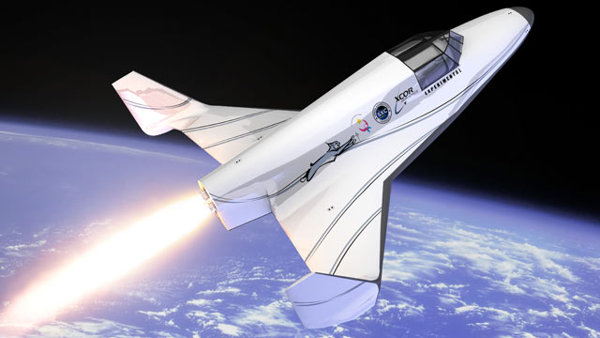 (Photo Credit: XCOR)Outer space just seems a bit closer these days. Just weeks after Austrian daredevil Felix Baumgartner awed the world with a stratospheric skydive, a California aerospace firm is hoping send even more people to the edge of space with a hypersonic aircraft capable of cruising at 3.5 times the speed of sound.
(Photo Credit: XCOR)Outer space just seems a bit closer these days. Just weeks after Austrian daredevil Felix Baumgartner awed the world with a stratospheric skydive, a California aerospace firm is hoping send even more people to the edge of space with a hypersonic aircraft capable of cruising at 3.5 times the speed of sound.
Mojave-based XCOR is currently busy constructing the “Lynx,” a two-seater commercial craft supposedly capable of cruising 62 miles above the Earth’s surface at speeds of more than 2,500 miles per hour.”I’m excited as hell,” XCOR Chief Operating Officer Andrew Nelson told ABC News. “It’s going to be the most exciting suborbital space flight you will ever take.”
The ride, the entirety of which takes about 30 to 45 minutes, consists of a rocket-powered ascent, several minutes of microgravity coasting near the edge of space, re-entry and a gliding landing similar to that of a space shuttle.
Though the Lynx is drawing comparisons with the Concorde, the supersonic passenger jet retired from service in 2003, Nelson stressed that the Lynx isn’t meant to fly from city to city.
“The Lynx will not fly from New York to Tokyo in 90 minutes,” he said. “It’s designed to go up and come down. When you start going sideways real fast through the atmosphere, you build up a ton of heat.”
If you have a cool $95,000 to splash around, Lynx suborbital flight tickets are being sold right now on the company’s website. A ticket includes a medical screening and g-force training for the passenger and “fellow space travelers.”
Despite the hefty price tag, XCOR apparently isn’t suffering from lack of demand.
“We’ve already sold over 225 seats, and those sales are accelerating,” Nelson said. “And those include both personal space flights as well as science flights.”
XCOR expects to begin offering flights on the new plane beginning in 2013 and hopes to conduct about four flights a day.
So what exactly is it like to take part in this suborbital joyride?
“You basically become a rocket,” said Nelson, describing take-off. “After about 50 seconds, you are past mach 1 and you continue to accelerate and climb.
“You’ll get fitted for a pressure suit, like Felix Baumgartner,” Nelson said. “The pressure suit is not too dissimilar to that. You’ll also have a parachute you’ll put on, just in case.
“It takes only 4.5 minutes to get to the very top and hit at your peak rate of velocity of 3,300 feet per second,” he said. “That’s faster than the muzzle velocity of a standard rifle.”
Nelson added that his company doesn’t plan to enlarge the aircraft to accommodate more passengers in the near future.
“At the moment, we don’t have a plan to make it larger, but that doesn’t mean we won’t make a derivative in the future,” he said. “We think it’s the right vehicle for the right time. … We are planning a future orbital vehicle and that will have more seats, we see Lynx as a stepping stone to a reusable orbital system.”
To that end, Nelson believes that within eight to 10 years, aircraft like the Lynx could be bringing astronauts to the international space station and back.
“It won’t be the Lynx, but it will be the son of the Lynx,” he said.
Nelson also hopes to take advantage of the Lynx’s capabilities to conduct a variety of scientific experiments, including those submitted to him by children and students.
“The long-term impact the Lynx is going to have is on kids and getting them energized again about science and mathematics and engineering,” said Nelson.
CalPilots Editor’s Note: XCOR was one of the companies kind enough to provide us a presentation of what they are working on during our annual meeting in Mojave in Oct 2012
